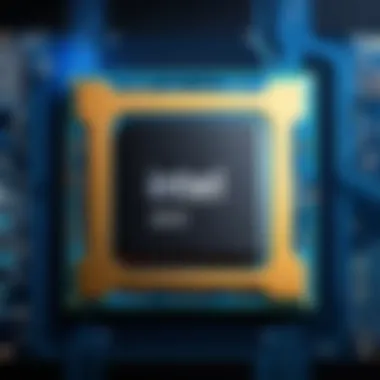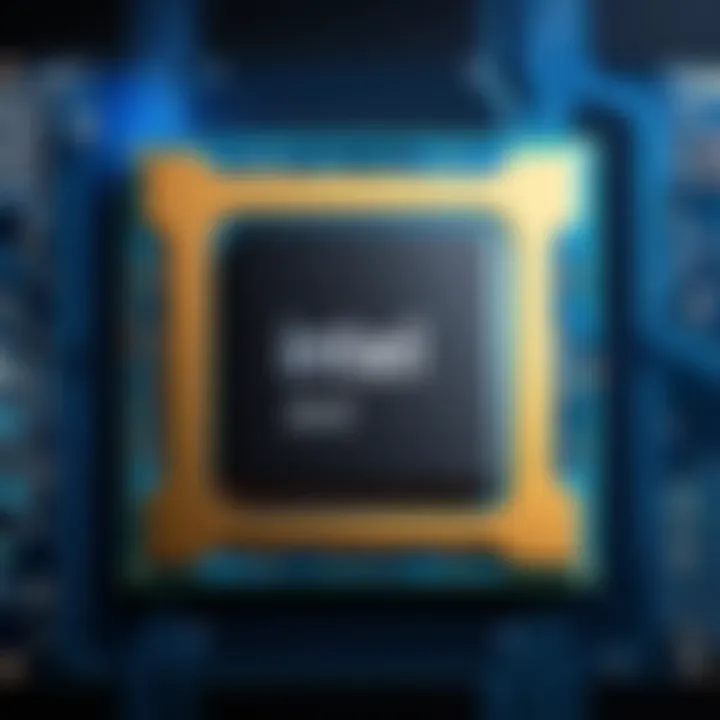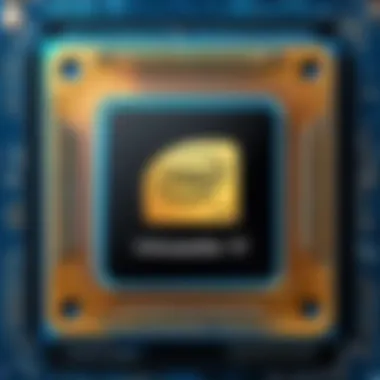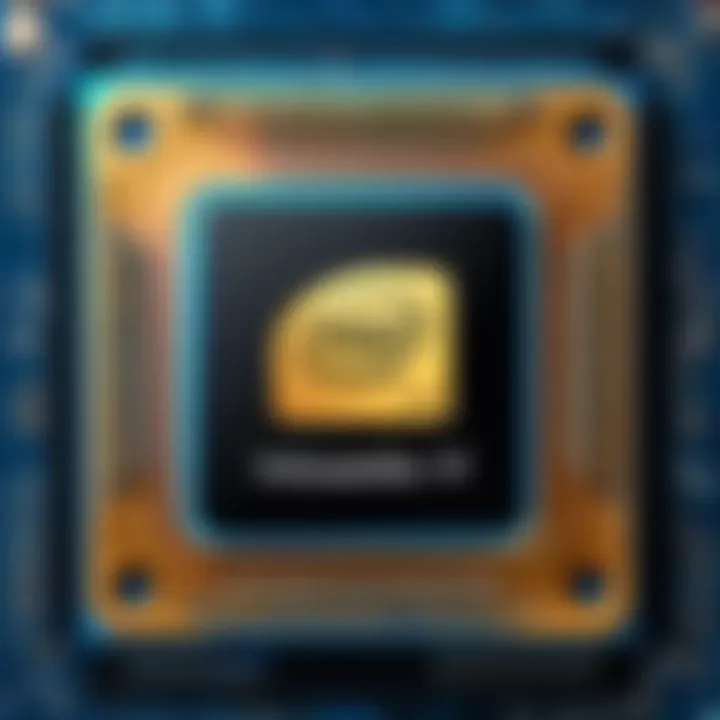Exploring the Intel i9 12: Architecture and Performance


Intro
The Intel i9 12 processor represents a significant advancement in computing technology, targeted to meet the demands of tech enthusiasts, gamers, and IT professionals. Understanding its architecture, performance metrics, and applications forms a crucial part of evaluating its value and capabilities. This article aims to provide an in-depth exploration of the Intel i9 12, analyzing its features and the impact it has on high-performance computing.
Product Overview
Brand Information
Intel Corporation has long been a leader in computing technology, specializing in semiconductor manufacturing. The i9 series is well-known for its power and efficiency, primarily aimed at gamers and professionals demanding superior performance.
Key Specifications
The Intel i9 12 is characterized by several key specifications:
- Cores/Threads: The i9 12 features a multi-core architecture with 16 cores and 24 threads, which enhances its multitasking capabilities.
- Base Clock Speed: It boasts a base clock speed of 3.2 GHz, with the ability to reach up to 5.2 GHz with Turbo Boost technology.
- Cache Memory: The processor includes a sizeable cache of 30 MB Intel Smart Cache, which aids in speeding up data access.
- TDP: It has a Thermal Design Power (TDP) of 125 watts, making it efficient in terms of heat generation relative to its performance.
Pricing
Pricing for the Intel i9 12 varies based on retailer and market conditions, but it generally retails around $600 to $700. This positioning reflects its high-end capabilities and competition within the market.
Performance Comparison
Benchmark Tests
Benchmark tests consistently show that the Intel i9 12 outperforms many of its predecessors and competitors. For example, in Cinebench R23, it often achieves scores that put it well ahead in rendering tasks.
Speed and Efficiency Comparisons
When comparing the i9 12 with earlier i7 models, the jump in speed is notable. Users can expect a significant increase in efficiency during intensive workflows, such as 3D rendering and video editing, making it a worthwhile upgrade for professionals.
Features and Technology
Unique Features
Some of the unique features of the Intel i9 12 include:
- Enhanced AI Capabilities: The processor has advanced AI integration, allowing for intelligent performance optimization.
- PCIe 4.0 Support: This enables faster data transfer rates and better graphics card performance.
Technological Advancements
Technological advancements are evident in the i9 12 architecture, significantly improving its processing power compared to older models. It is built on Intel’s latest microarchitecture, making it suitable for future applications.
Compatibility with Other Devices
The i9 12 is compatible with various motherboards and GPUs, ensuring that users can build or upgrade systems that meet their specific needs.
Pros and Cons
Strengths of the Product
- High Performance: The i9 12 excels in demanding applications.
- Future-Proofing: With its advanced technology, it is built to last.
- Great Multitasking: Multiple cores enhance productivity by efficiently handling concurrent tasks.
Areas for Improvement
- Power Consumption: The TDP might be a concern for users seeking extreme energy efficiency.
- Pricing: It stands at a premium price point that may not fit all budgets.
Value for Money
Cost-Effectiveness
While the initial investment is high, the long-term benefits likely make the Intel i9 12 a cost-effective choice for users needing high-performance computing.
Long-Term Benefits


Investing in this processor can lead to superior performance in various applications, ensuring it remains relevant for future software needs.
Comparison with Similar Products
In comparing the Intel i9 12 to alternatives such as the AMD Ryzen 9 5900X, Intel holds its ground in gaming performance, though pricing can be a deciding factor for some consumers.
"The Intel i9 12 processor is a powerful tool for professionals and gamers alike, merging speed with cutting-edge technology."
Overview of Intel's i9 Processor Line
The Intel i9 processor line represents a significant evolution in microprocessor technology, specifically tailored for enthusiasts and professionals who demand high-performance computing. Understanding this line is crucial, as it provides insights into Intel's response to emerging challenges in computing, including the need for speed, efficiency, and multitasking capabilities. The i9 series is a testament to Intel's commitment to pushing boundaries and setting benchmarks in processing power.
Historical Context
The inception of the Intel i9 processor line can be traced back to the growing demands of consumers and the increasing complexity of software applications. Launched in 2017, the first generation of Intel i9 processors marked a shift away from the mainstream i7 lineup, introducing features aimed at professionals in gaming, content creation, and computational tasks. The architecture was designed to handle more cores and threads, accommodating the needs of users engaged in tasks like video editing and high-end gaming.
The landscape of computing was changing; workloads were becoming more parallelized, and software was increasingly optimized for multi-threading. Consequently, Intel recognized the necessity to innovate. This led to the introduction of the i9 series, boasting higher clock speeds and enhanced thermal conditions. The essence of this progression lies in Intel’s historical ability to adapt and respond to the dynamic needs of the market.
Generational Improvements
Each generation of Intel’s i9 processors showcases distinct improvements over previous iterations. The 10th generation brought new architectures, enabling advanced features like Turbo Boost Technology 3.0, which optimizes performance by dynamically adjusting power and clock speed for demanding tasks. The introduction of Intel’s Hyper-Threading technology allowed for increased multi-threading capabilities across all cores, which significantly improved performance in threaded applications.
The leap to the 11th generation saw enhancements in integrated graphics and support for faster RAM, further increasing the processor’s efficiency and responsiveness. Now, with the 12th generation, the introduction of a hybrid architecture enables a blend of performance and efficiency cores, addressing diverse workloads with significantly improved performance per watt.
The advancements in each generation of Intel’s i9 processors are critical for users who rely on their systems for high-performance tasks. These improvements pave the way for applications that demand increasingly complex calculations and real-time processing.
Overall, the comprehensive evolution of the Intel i9 processor line is not merely a series of innovations but a reflection of the rapidly changing technological needs and expectations in the industry. It establishes a framework for understanding how processor architecture can evolve to meet the growing demands of high-performance computing.
Architecture of the Intel i9
The architecture of the Intel i9 12 processor represents a significant evolution in Intel's line of high-performance CPUs. Understanding its architecture is vital for tech enthusiasts, gamers, and IT professionals alike, as it impacts overall system performance. This section will explore key components such as core and thread count, cache design, and process technology, each contributing to the effectiveness and efficiency of the i9 12. These factors not only affect how tasks are processed but also influence power consumption and thermal performance, making this information critical for informed purchasing decisions and system designs.
Core and Thread Count
The Intel i9 12 features a high core and thread count, aligning with modern computing demands. This processor comes with up to 16 cores and 24 threads, which is a marked improvement over previous generations. Each core can handle a separate task independently, while threads facilitate efficient multitasking by sharing core resources. This architecture allows for better performance in multi-threaded applications such as video editing, 3D rendering, and intensive gaming sessions.
An important aspect of core and thread utilization is the Hyper-Threading technology, which Intel has incorporated into the i9 12. Hyper-Threading effectively doubles the number of threads per core, enhancing the CPU's efficiency. This results in improved performance, especially in workload-intensive scenarios.
Cache Design
Cache design is another crucial component of the i9 12 architecture. The processor utilizes a three-tier cache hierarchy comprising L1, L2, and L3 caches. The L1 cache is the fastest and is built into each core. It functions as a temporary storage area for frequently accessed data. L2 cache follows and is also core-specific but larger than L1. The L3 cache is shared among all cores, designed to optimize data access across the processor.
Such a cache architecture significantly reduces latency and improves throughput, making data retrieval more efficient. In practical terms, this means faster application launches, reduced load times in games, and smoother performance during heavy multitasking.
Process Technology
The Intel i9 12 is manufactured using a refined 10nm SuperFin process technology. This advancement results in better power efficiency and performance compared to earlier lineups that relied on larger node sizes. The smaller transistors allow for higher clock speeds while reducing heat generation and power consumption, which is critical for maintaining performance under heavy loads.
This 10nm process technology not only enhances speed but also paves the way for future optimizations. The combination of advanced architecture and modern fabrication techniques ensures that the Intel i9 12 remains competitive in a rapidly evolving market. The lower thermal output also means less stringent cooling solutions can be implemented, simplifying overall system design.
"A better architecture leads to sustained performance improvements across multiple applications, proving crucial for power users."
Performance Analysis
Performance analysis stands as a cornerstone in understanding the capabilities of the Intel i9 12 processor. This segment evaluates the efficiency and speed of the processor through various metrics and tests. Analyzing performance offers insightful information about how the processor performs under different conditions, which is essential for users making informed decisions. It also aids in identifying potential bottlenecks, which can be pivotal in optimizing overall system performance.
Synthetic Benchmarking
Synthetic benchmarking acts as a controlled environment to measure the raw performance of the Intel i9 12. These tests evaluate processor capabilities through standardized workloads, allowing for a direct comparison against other processors. Tools such as Cinebench R23 and Geekbench 5 come in handy, placing stress on the CPU to gauge its limits.
The results from synthetic benchmarks provide clear metrics on single-core and multi-core performance. It is crucial for enthusiasts and professionals who need to understand how the i9 12 stacks up against both its predecessors and competing models in peak conditions. For example, Intel i9 12 scores significantly higher than the i7 models, particularly in multi-threaded tasks, showcasing its superior architecture and thread count.
Real-World Performance Metrics
Real-world performance metrics go beyond theoretical numbers. This evaluation focuses on practical applications and everyday usage scenarios where the Intel i9 12 excels. Metrics may include file compression times, video rendering speeds, and application load times. For instance, in intensive tasks like video editing with Adobe Premiere Pro, the Intel i9 12 shows impressive efficiency, often reducing render times compared with previous generations of processors.


Users benefit from understanding how the processor performs in actual use cases, as it gives a realistic portrayal of system capabilities. The performance also varies depending on workload types, so examining task-specific metrics is vital for buyers.
Gaming Performance Review
Gaming performance is a significant concern for many users considering the Intel i9 12. Various factors like frame rates, resolution, and overall gaming experience are crucial points of evaluation. The i9 12 demonstrates outstanding performance in contemporary games, consistently achieving high frame rates even at maximum settings.
Specifically, games such as Call of Duty and Cyberpunk utilize the processor’s capabilities effectively, leveraging its core and thread count to provide a smooth experience. The IPC (instructions per clock) improvement in this generation contributes notably to gaming performance, allowing the processor to handle complex tasks without lag.
"The Intel i9 12 not only meets but exceeds expectations for gaming, seamlessly delivering high performance with minimal thermal throttling."
Power Consumption and Thermal Performance
Power consumption and thermal performance are crucial aspects when evaluating processors. They not only influence the overall system efficiency but also have a significant impact on the longevity and stability of high-performance systems. In the case of the Intel i9 12 processor, understanding how these factors play into its design and usage is essential for tech enthusiasts and professionals alike.
TDP Ratings
TDP, or Thermal Design Power, represents the maximum amount of heat a processor is expected to generate under typical workloads. For the Intel i9 12, this rating is typically between 125W to 150W, depending on the specific variant. This indicates that system designers should plan for adequate cooling solutions to maintain optimal performance levels.
The significance of TDP ratings goes beyond mere numbers. A higher TDP often allows for better performance during demanding tasks, but it can also lead to increased power consumption.
When assessing TDP, it is important to consider the following:
- System Compatibility: Ensure that the motherboard and power supply can handle the required wattage.
- Cooling Requirements: Higher TDP ratings necessitate advanced cooling strategies to prevent thermal throttling, where the processor reduces its performance to lower temperatures.
- Electrical Efficiency: Understanding how power consumption affects overall energy costs influences decisions for both home and enterprise systems.
Cooling Solutions
Cooling solutions are paramount to ensuring the Intel i9 12 operates within safe temperature ranges. Effective cooling extends the lifespan of the processor and maintains consistent performance. There are several cooling solutions available for the i9 series, each with its pros and cons.
- Air Coolers: These are less expensive and easier to install. High-quality air coolers can provide sufficient cooling for the i9 12. However, they may be less effective under sustained heavy loads compared to liquid cooling solutions.
- Liquid Cooling Systems: Liquid cooling is often preferred for high-performance builds, particularly those using the Intel i9 12. A liquid cooling system can offer superior thermal performance, handling the heat generated during intense computational tasks effectively. Some popular liquid cooling brands include Corsair and NZXT.
- Custom Cooling Loops: For enthusiasts, custom liquid cooling loops offer the best performance and aesthetics. However, they are more complex and require a deeper understanding of thermal management.
Effective cooling not only supports performance but also allows overclocking, which can unlock additional capabilities of the i9 12. It is crucial for users to choose a cooling solution that aligns with their performance needs and system constraints.
In summary, managing power consumption and thermal performance is essential for anyone using the Intel i9 12 processor. It can impact everything from energy costs to system reliability.
Comparisons with Other Processors
The comparison of the Intel i9 12 with other processors is crucial in understanding its place in the ever-evolving landscape of computing technology. Evaluating its capabilities against those of Intel's i7 and i5 series, as well as AMD's Ryzen array, offers insights into performance variations, pricing, and usability in different contexts. This section serves to highlight the distinctions and similarities that potential buyers or enthusiasts should consider when choosing a CPU for their needs.
Intel i7 and i5 Comparison
When looking at the Intel i9 12, it becomes essential to contrast it directly with the Intel i7 and i5. The i7 series has long been known for offering a solid balance between performance and cost, making it popular among gamers and content creators. However, the i9 12 takes performance a step further with a higher core and thread count, leading to improved multitasking and handling of demanding applications.
- Core Count: The Intel i9 12 typically features more cores than i7 or i5, often having 8 to 16 cores, while i7 ranges generally from 6 to 8 cores and i5 from 4 to 6 cores. This core advantage allows the i9 to perform significantly better in tasks that can utilize multiple threads.
- Clock Speeds: The i9 processors usually have higher boost clock speeds. This can enhance performance in single-threaded applications, like many games, where maximum clock speed is more beneficial than just core count.
- Price Point: The pricing of the i9 is notably higher than i7 and i5. Choosing an i9 may be justified for users who require extreme performance, whereas i7 or i5 might be more sensible for budgets and moderate performance needs.
AMD Ryzen Comparison
Another important comparison involves AMD's Ryzen series, which has carved a strong position in the market. Ryzen processors often feature competitive performance and aggressive pricing. When examining the Intel i9 12 in this context, several factors emerge:
- Architectural Differences: AMD's Ryzen processors leverage their Zen architecture, allowing for a great number of cores and excellent multitasking abilities. Similar to i9, Ryzen 9 does have high core counts, leading to comparable performance in many use cases.
- Gaming Performance: Although Intel has traditionally dominated gaming performance, Ryzen's advancements have narrowed the gap. Certain workloads may favor one architecture over the other, and users should analyze benchmarks pertaining to their intended usage.
- Thermal Management: AMD's chips, in many cases, run at lower temperatures under load than Intel's current offerings. This can lead to quieter operation and may lessen the requirement for elaborate cooling solutions.
"Selecting the right CPU depends not only on specifications but also on intended use cases and budget considerations."
Understanding these comparisons between the Intel i9 12 and its counterparts reveals much about its positioning and value proposition in the market. Each user's specific requirements will determine which processor best suits their needs.
Use Cases and Applications
The Intel i9 12 processor offers versatile applications that cater to various user needs. Understanding the specific use cases is crucial for anyone considering this processor. Each use case highlights strengths in performance and can influence purchasing decisions. It’s also important to account for the specific benefits and considerations unique to each application, as these factors determine the processor's relevance in the user's landscape.
Gaming Rigs
Gaming is perhaps the most popular use case for the Intel i9 12. The demand for high frame rates and smooth gameplay drives gamers to seek robust processors. The i9 12 excels in this environment due to its high core and thread count, which ensures that games run smoothly even with demanding graphics and extensive background processes. Advanced games can utilize multiple threads efficiently, taking full advantage of the i9 12's architecture.
The processor's ability to boost clock speeds also enhances gaming performance, which translates to reduced lag during intense gaming sessions. When combined with a capable GPU, users experience improved graphics fidelity that adds richness to interactive environments.
"The Intel i9 12 provides gamers with the resources to tackle the most demanding titles available today."


Content Creation
For content creators, the Intel i9 12 offers the necessary processing power for tasks ranging from video editing to 3D rendering. Software like Adobe Premiere Pro and Blender benefit from the higher core counts. These applications perform well because they can utilize multiple cores for rendering tasks, which significantly speeds up production workflows.
Moreover, the i9 12’s large cache allows for quicker data access during complex tasks. This reduces bottlenecks and enhances overall efficiency in content production. The advantage here is not just in processing power but also in time saved on projects.
When high-resolution footage or intricate designs are involved, having a powerful processor makes a profound difference.
Scientific Computing
The Intel i9 12 is also suitable for scientific computing tasks, such as simulations, data analysis, and machine learning. These fields often require heavy computational power and can significantly benefit from the parallel processing capabilities that the i9 12 offers. The processor’s architecture is well-suited for handling vast datasets and complex calculations, making it a viable choice for researchers and professionals in these domains.
In addition to performance, efficiency matters. Scientific applications often demand long run-times, so thermal performance and power consumption are vital considerations. The i9 12 manages these well, providing stable performance across prolonged periods, which is essential in scientific research.
Market Position and Trends
The Intel i9 12 holds a significant position in the landscape of high-performance processors. Analyzing market position and trends is crucial to understanding how this processor compares with others and the factors that influence its usage. The relevance of this topic extends beyond mere numbers. It informs potential buyers and industry professionals about the capabilities and value of the i9 12 in various settings.
Pricing Analysis
The pricing of the Intel i9 12 reflects its high-performance designation. Various retailers and e-commerce platforms list it at a premium compared to other processors. Factors influencing its price includes:
- Manufacturing Costs: Advanced technology and materials used in the i9 12 increase production costs.
- Demand for Performance: As more gamers and professionals seek cutting-edge processing power, the high demand supports a higher price point.
- Market Competition: Despite competing products, Intel's branding and reputation can justify the costs associated with the i9 12.
When considering purchase options, understanding the pricing strategy is important. Buyers should compare the i9 12 against its competitors like the AMD Ryzen series, keeping in mind user requirements and performance needs.
Competitive Landscape
The competitive landscape for the Intel i9 12 is dominated by rival processors from AMD, in particular the Ryzen 9 series. Key elements include:
- Specifications: Intel's i9 12 often features higher clock speeds and better single-thread performance than many of its rivals. This is essential for tasks requiring fast response times.
- Market Share: Intel still commands a larger share of the CPU market, but AMD's advancements have narrowed the gap over the years.
- Technological Innovations: Both companies continuously innovate. The i9 12's integration of novel technologies plays a big role in its standing against AMD's offerings.
Overall, understanding the competitive landscape helps grasp not just the i9 12’s strengths, but also where it could be vulnerable. An informed analysis aids consumers in selecting the best processor according to their specific needs, showcasing the relevance of both pricing and competition in the market.
Future of the Intel i9 Processors
The future of the Intel i9 processors is a crucial topic in today's rapidly evolving tech landscape. As computing needs grow more sophisticated, the demands for processor performance and efficiency also increase. Intel's i9 line, being at the pinnacle of their offerings, is poised to lead in these advancements. This section explores the potential developments in architecture and anticipated industry shifts that will shape the future of the Intel i9 processors. Understanding these elements helps both enthusiasts and professionals grasp how innovation continues to influence high-performance computing.
Next-Gen Architecture
The next generation of Intel i9 architecture is expected to focus on increased core counts and improved efficiency. Recent trends show that multi-threading is becoming essential in various applications. Such advancements will likely include optimizations in thermal design, leading to better performance per watt. The integration of newer manufacturing processes, possibly utilizing 7nm or smaller technology, will allow for more transistors on a chip, enhancing performance without significantly impacting power consumption.
Furthermore, a shift towards heterogeneous architectures—where different types of processing cores are employed—could be a game changer. These designs can dynamically allocate tasks to the most suitable core type, improving overall performance in diverse workloads without sacrificing efficiency. Intel is also likely to invest in AI-enhanced features. Such advancements would enable the chip to learn and adapt to user behavior, optimizing processes in real time.
Anticipated Industry Shifts
As Intel continues to evolve its processors, the market landscape is also set to change in various ways. Competition from AMD, particularly with the Ryzen series, has forced Intel to innovate at a faster pace. The race for performance supremacy will lead to both companies pushing boundaries, resulting in enhanced offerings for consumers.
Another significant shift is the increasing reliance on cloud computing and data centers. High-performance processors will play a critical role in these environments. Intel's i9 processors might integrate enhanced features aimed at cloud optimization, such as improved security protocols and specialized processing for AI workloads.
The rise of remote work and online gaming will also drive demand for high-powered consumer processors. As more individuals build gaming rigs or powerful content creation systems at home, Intel’s products, particularly the i9 line, will likely see increased sales.
Finale
The importance of concluding an article about the Intel i9 12 processor lies in reinforcing the main points discussed while offering the reader a synthesis of the insights provided. In this article, we evaluated critical aspects such as architecture, performance metrics, and practical applications. These discussions help clarify the i9 12's role in the rapidly evolving landscape of computing technologies.
Summarizing Key Insights
Several key insights emerged throughout the article:
- Performance Dominance: The Intel i9 12 processor demonstrates performance capabilities that exceed previous generations significantly. This leap allows users to experience enhanced speed and efficiency, especially in demanding applications like gaming and content creation.
- Architectural Enhancements: With advanced caching mechanisms and an optimized core design, the i9 12 ensures that it can handle parallel tasks more efficiently. This design consideration is crucial for heavy workloads where performance bottlenecks often occur.
- Market Position: Understanding the competitive landscape revealed that the i9 12 is well-positioned against both its Intel siblings, like the i7 and i5 processors, and rival offerings from AMD, such as the Ryzen series. Its pricing, specifications, and performance contribute to its appeal in a crowded marketplace.
These insights collectively illustrate how the Intel i9 12 processor represents a significant step forward in high-performance computing.
Final Thoughts on i9
As we look to the future, the Intel i9 12 processor stands out for its advanced technology and robust performance capabilities. It caters well to tech enthusiasts, gamers, and professionals who require reliable and powerful hardware. The combination of processing power, efficient thermal management, and overall system performance makes it a compelling choice.
Future Considerations: As technology continues to evolve, staying informed about updates and enhancements in processors like the i9 12 is essential. The industry trends suggest an increasing focus on energy efficiency and processing power, paving the way for even more innovative designs. This evolution promises to keep Intel at the forefront of the computing technology landscape.
In summary, the Intel i9 12 processor is not just another hardware upgrade; it signifies a shift toward superior computing performance that meets the demands of modern applications. Engaging with such advancements is crucial for anyone invested in high-performance computing.







